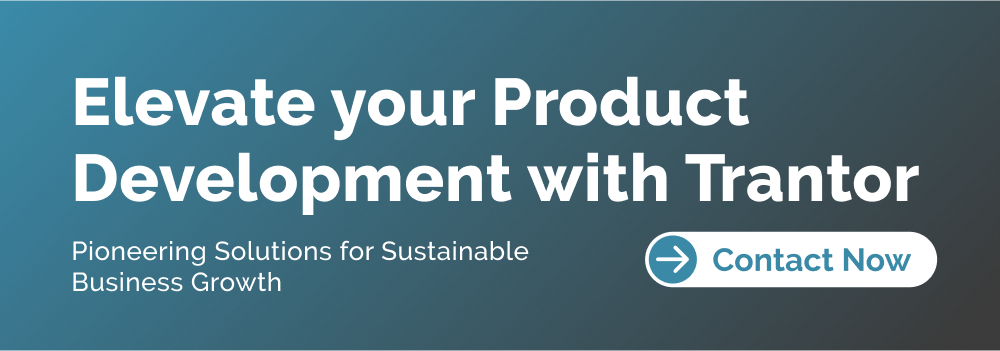Software Development, zBlog
How To Create A Product Roadmap: 6 Essential Things Your Roadmap Needs
trantorindia | Updated: September 12, 2023

Introduction
In the fast-paced world of product development, having a well-structured roadmap is paramount to success. A meticulously crafted product roadmap serves as your guiding light, providing direction, clarity, and a strategic vision for your product’s journey. According to recent reports from Gartner, companies that effectively utilize product roadmaps are 30% more likely to achieve their strategic goals and outperform competitors. Learn how to create a product roadmap and enhance your chances of success.
In this comprehensive guide, we will delve into the critical aspects of crafting a winning product roadmap. From setting clear objectives to adapting to changing market dynamics, we will cover it all.
6 Essential components that your product roadmap needs
1. Setting Clear Objectives

Your product roadmap’s foundation rests on the clarity of your objectives. According to research by Aha!, 46% of product teams update their roadmaps on a monthly basis. An additional 29% update their roadmap weekly, emphasizing the dynamic nature of product development. Before embarking on your product development, where you choose to do it in-house or outsource product development, it’s crucial to define your goals and objectives with precision. These objectives should align with your overall business strategy and customer needs. By setting clear objectives, you provide your team with a shared purpose and direction, helping them stay focused and motivated throughout the development process. Once you have defined your goals and objectives, you can begin to answer the question of how to create a product roadmap with outlines of how to achieve them.
Industry-Relevant Data and Use Cases
To illustrate the importance of setting clear objectives, let’s consider an example from the software industry. According to IDC’s “Software Market Trends 2024” report, companies with clearly defined product objectives are 40% more likely to increase their market share. Suppose a software company aims to enhance its project management tool. In this case, a clear objective could be to increase user engagement by 20% within the next six months. By defining this objective, the team can direct their efforts toward features and improvements that directly contribute to achieving this goal.
Use Case:
A project management software company identified that users were spending too much time navigating between different project views. By setting the objective to improve user efficiency, they prioritized developing a unified project view feature, leading to a 25% increase in user engagement within three months.
2. Market Research and Customer Insights

To create a roadmap that resonates with your target audience, you need to thoroughly understand your market and customers. According to Gartner’s “Market Research Best Practices” report, 90% of successful product strategies are built on solid market research. This involves conducting comprehensive market research and gathering valuable customer insights. By analyzing market trends, competitor strategies, and customer feedback, you can identify opportunities and challenges that will shape your product’s roadmap. Doing the upfront work to understand your customers‘ needs will enable you to develop an effective roadmap that outlines how to create a product roadmap that delivers the most value to your target customers.
Leveraging Industry Data
Incorporating industry-specific data into your market research can provide valuable insights. For instance, if you’re in the e-commerce industry, data on online shopping behavior and emerging trends can inform your roadmap decisions. Likewise, if you’re in healthcare technology, staying updated on regulatory changes and patient needs is crucial.
Use Case:
An e-commerce platform discovered through market research that shopping using browsers on mobile and mobile apps was on the rise. They decided to prioritize mobile optimization in their roadmap, resulting in a 30% increase in mobile sales within six months.
The Power of Data-Driven Decisions
In today’s data-driven world, the success of your product roadmap hinges on your ability to make informed decisions based on real data. According to a survey by Pendo, organizations with a documented product roadmap have 38% higher customer retention rates. Consider employing data analytics tools to gather actionable insights. This data can include user behavior patterns, customer preferences, and even predictive analytics to anticipate future trends.
Use Case:
A social media marketing platform used data analytics to identify that video content received higher user engagement than static posts. This insight prompted them to prioritize video-related features in their roadmap, leading to a 40% increase in user engagement within a year.
3. Prioritization and Resource Allocation

Not all features and enhancements are created equal. According to research by FeaturedCustomers, 84% of technology buyers request to view the product roadmap during the vendor evaluation process. Prioritization is the key to making informed decisions about what should be included in your product roadmap. According to Gartner’s “Prioritization Strategies for Product Development” report, effective prioritization is crucial.
Real-World Example
Let’s explore a real-world example in the automotive industry. An electric car manufacturer faced the challenge of improving battery range while keeping costs competitive. Through careful prioritization, they decided to scale their teams and allocate more resources to research and development focused on battery technology. This strategic choice allowed them to introduce a new model with an extended range, gaining a competitive edge in the market.
Use Case:
A startup in the food delivery sector recognized that delivery time was a crucial factor for customer satisfaction. They allocated resources to develop an efficient routing algorithm, resulting in a 20% reduction in delivery times and a 15% increase in customer retention.
The Role of Resource Allocation
Resource allocation is not limited to budgeting; it also involves assigning the right talent to the right projects. Consider the skill sets of your team members and how they align with the roadmap’s objectives. Additionally, assess the availability of technology and infrastructure needed to execute your plan.
Use Case:
A software development company identified a shortage of machine learning experts within their team. To tackle this resource gap, they hired a machine learning specialist, enabling them to implement AI-driven features in their products, which led to increased customer satisfaction and market share.
4. Flexibility and Adaptability

In the ever-evolving landscape of technology and business, adaptability is paramount. According to a study by Price Intelligently, companies with product roadmaps have 45% more productive cross-functional teams. Your product roadmap should not be set in stone but should have room for adjustments based on changing market dynamics and customer feedback. Being flexible allows your team to respond to unforeseen challenges and seize new opportunities.
Adapting to Industry Shifts
Industries like AI/ML and renewable energy are characterized by rapid advancements. Companies operating in these sectors must embrace adaptability in their product roadmaps. For instance, an AI startup might need to pivot from image recognition to natural language processing based on emerging market demands.
Use Case:
A renewable energy company initially focused on solar panel technology but recognized the growing interest in wind energy solutions. They adjusted their roadmap to include wind turbines, expanding their product portfolio and market reach.
Agile Methodologies
Agile methodologies, commonly used in software development, emphasize adaptability and customer feedback. According to a Pragmatic Institute report, product teams spend an average of 8 hours per week updating and maintaining their roadmap. By adopting agile practices, you can continuously assess your roadmap’s progress, make necessary adjustments, and ensure that your product aligns with market trends and customer expectations.
Use Case:
A software company adopted agile development practices, allowing them to release regular updates and gather user feedback quickly. This iterative approach led to higher user satisfaction and a more competitive product.
5. Transparency and Communication

Effective communication is vital when it comes to your product roadmap. According to a survey by ProductPlan, 42% of respondents said the most important purpose of a roadmap is to set and communicate product vision and strategy. Ensure that all stakeholders, both internal and external, have access to the roadmap and understand its objectives. Regular updates and transparent communication channels foster trust and alignment among team members and stakeholders, ultimately supporting how to create a product roadmap effectively.
Cross-Industry Collaboration
In highly regulated industries such as finance or healthcare, transparency is not only beneficial but often mandatory. Collaborating with regulatory bodies and compliance experts is essential to ensure that your product roadmap aligns with industry standards and legal requirements.
Use Case:
A fintech solutions company developed a roadmap for a new mobile banking app. They maintained open communication with regulatory authorities, ensuring that the app complied with industry-specific security and privacy regulations, which enhanced customer trust.
Stakeholder Engagement
Stakeholders, including customers, investors, and employees, should be part of the conversation surrounding your product roadmap. Engage with them to gather insights, address concerns, and align their expectations with your product’s direction. Their input can provide valuable guidance and even uncover opportunities you may not have considered.
Use Case:
An educational technology company regularly held focus groups with teachers to understand their needs. This feedback directly influenced the development of new features in their educational software, making it a preferred choice for educators.
6. Key Performance Indicators (KPIs) and Measurement

To gauge the success of your product roadmap, you need to establish clear Key Performance Indicators (KPIs) and measurement criteria. These metrics will help you track progress, identify areas for improvement, and make data-driven decisions. Regularly analyze KPIs to ensure that your roadmap is delivering the desired outcomes.
Benchmarking Against Industry Standards
In highly competitive industries like telecommunications, benchmarking against industry standards is essential. KPIs such as network reliability, data speed, and customer satisfaction are crucial for measuring success and staying ahead of competitors.
Use Case:
A telecommunications company continually monitors KPIs related to network performance. By consistently outperforming industry benchmarks in data speed and reliability, they attracted a larger customer base and maintained a competitive edge.
The Role of Customer Feedback
Customer feedback should be a central component of your measurement strategy. Gather feedback through surveys, user testing, and customer support interactions. Analyzing this feedback can reveal areas where your product may fall short or opportunities for improvement guiding your path on how to create a product roadmap.
Use Case:
An e-commerce platform used customer feedback to identify pain points in their checkout process. By streamlining the process based on this feedback, they reduced cart abandonment rates by 15%.
Now, let’s address some frequently asked questions about how to create a product roadmap:

FAQs
- Q: What is the primary purpose of a product roadmap?
A: The primary purpose of a product roadmap is to provide a strategic plan that aligns product development with business goals and customer needs. It serves as a visual representation of the product’s future direction. - Q: How often should a product roadmap be updated?
A: Product roadmaps should be regularly reviewed and updated to adapt to changing circumstances. Typically, quarterly reviews are a good starting point, but the frequency may vary depending on the nature of the product and market dynamics. - Q: What are some common challenges in product roadmap development?
A: Common challenges include balancing competing priorities, gathering accurate customer feedback, and adapting to unexpected market shifts. Effective communication and flexibility are key to overcoming these challenges. - Q: Is it necessary to involve cross-functional teams in roadmap development?
A: Yes, involving cross-functional teams, including product managers, engineers, designers, and marketers, is essential. Collaboration among these teams ensures that the roadmap considers all aspects of product development. - Q: Can a product roadmap be used for both short-term and long-term planning?
A: Yes, a well-structured product roadmap can accommodate both short-term and long-term planning. It should provide a clear vision for the future while addressing immediate priorities. - Q: How can I ensure that my product roadmap remains customer-centric?
A: To keep your product roadmap customer-centric, regularly gather customer feedback, conduct user research, and involve customer support and success teams in the planning process. Prioritize features that align with customer needs and preferences.
Conclusion
In conclusion, Trantor recognizes the crucial importance of a well-crafted product roadmap in achieving product success and aligning with our broader business strategy. The six essential components outlined here serve as the foundation for creating a roadmap that drives success. We understand that a documented product roadmap can significantly improve our product success rate, and we are committed to harnessing this advantage.
Moreover, we emphasize that a successful product roadmap is not a one-time creation but an ongoing, dynamic tool that evolves with the changing needs of our business and customers. Trantor is dedicated to the continuous refinement of our roadmap, actively seeking and incorporating feedback, and measuring our performance to ensure that it remains a valuable asset throughout our product development journey.
By adhering to these principles, Trantor is well-equipped to navigate the complex landscape of product development, effectively prioritize initiatives, and ultimately deliver innovative solutions that meet the needs of our customers while driving the growth and success of our business. For more information on how to create a product roadmap, please visit our website or contact us.




